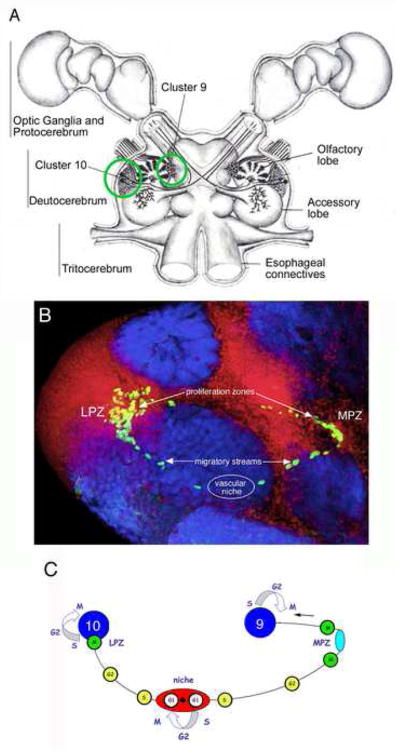Fig 2.

A. Diagram of the eureptantian (crayfish/lobster) brain including the optic ganglia, and showing the locations of the cell body clusters and neuropils. The bilateral soma clusters 9 and 10 (circled, left hemi-brain) are the locations where neurogenesis persists in the adult brain. These cell clusters flank two prominent neuropil regions of the deutocerebrum, the olfactory (OL) and accessory (AL) lobes. B.The proliferative system maintaining adult neurogenesis in the central olfactory pathway; shown here in images from the crayfish, Procambarus clarkii. Left side of the brain of P. clarkii labeled immunocytochemically for BrdU (green). Labeled cells are found in the lateral proliferation zone (LPZ) contiguous with Cluster 10 and in the medial proliferation zone (MPZ) near Cluster 9. The two zones are linked by a chain of labeled cells in a migratory stream that originates in the oval region labeled “niche”. Labeling for Drosophila synapsin (blue) and propidium iodide (red) is shown. C. Model summarizing our current view of events leading to the production of new olfactory interneurons in adult crayfish, clawed lobsters and crabs. Relatively quiescent precursor cells exhibiting glial characteristics reside within a neurogenic niche where they divide asymmetrically, resting in G1 phase of the cell cycle between divisions, to produce one self-renewed precursor cell and one daughter cell. Daughter cells begin migrating to the proliferation zones (lateral, LPZ, which contributes cells to Cluster 10; medial, MPZ, which contributes cells to Cluster 9), progressing from S phase of the cell cycle to the G2 phase as they migrate. Close to the proliferation zones these cells undergo mitosis to become third generation progenitors; one or more divisions of these cells will generate immature neurons in clusters 9 or 10. Many of these cells subsequently differentiate into olfactory interneurons and become incorporated into the nervous system as functional units. (Adapted from Sullivan et al., 2007b). Scale bar: B=100μm.
